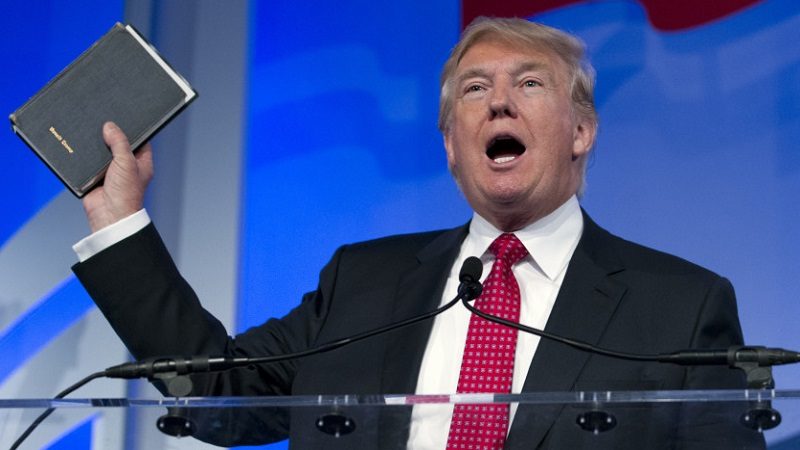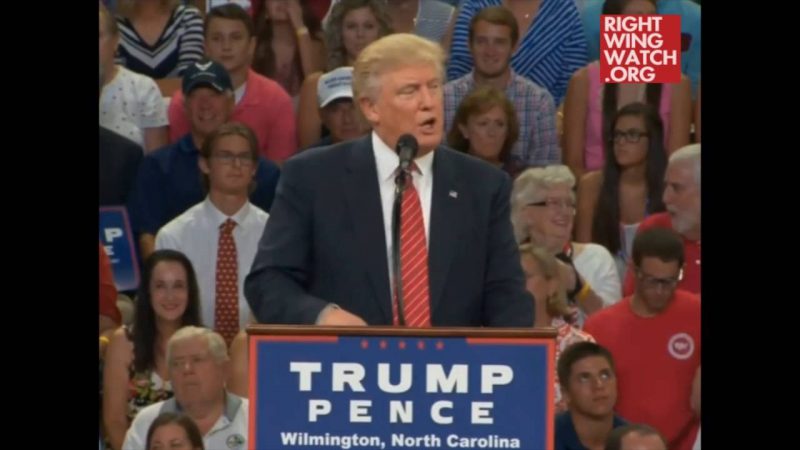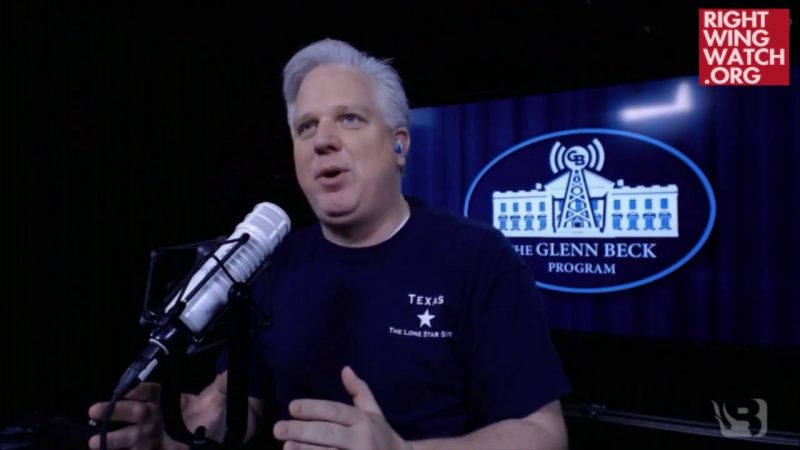At today’s March for Life, speaker after speaker hailed President Trump as nothing short of a movement hero, an emerging theme among activists trying to outlaw abortion.
Trump, who took several conflicting stances on abortion rights before wholly embracing the anti-abortion movement’s agenda, gave abortion rights opponents a gift this week when he reinstituted and expanded the “global gag rule,” also known as the Mexico City Policy.
But the cheering crowd at the March for Life didn’t seem to mind Trump’s advancement of any number of policies that can hardly be seen as promoting human life—some of which could even end up increasing abortion rates.
Here are five reasons to stop calling Donald Trump a “pro-life” politician:
1) Enforcing the Global Gag Rule
Trump’s decision to bring back the “global gag rule,” which prohibits U.S. funding to any foreign group involved in abortion in any way, such as referrals or advocacy, will cripple family planning services across the globe.
As we’ve noted, studies have found that defunding groups that provide contraception and family planning services may actually lead to an increase in rates of unintended pregnancies and abortions, especially unsafe abortions.
Trump even expanded on the gag rules that had been implemented by previous Republican presidents, jeopardizing groups working to prevent the rise of HIV/AIDS. Michelle Goldberg explains:
In the past, the global gag rule meant that foreign NGOs must disavow any involvement with abortion in order to receive U.S. family planning funding. Trump’s version of the global gag rule expands the policy to all global health funding. According to Ehlers, the new rule means that rather than impacting $600 million in U.S. foreign aid, the global gag rule will affect $9.5 billion. Organizations working on AIDS, malaria, or maternal and child health will have to make sure that none of their programs involves so much as an abortion referral.
Goldberg reports that Trump’s move could jeopardize funding to the thousands of HIV/AIDS organizations that rely on PEPFAR funding. Trump’s transition team has already questioned whether the U.S. should continue to fund PEPFAR, the successful HIV/AIDS testing, treatment and prevention program launched by George W. Bush, at all.
Trump similarly plans to defund Planned Parenthood in the U.S. and repeal the Affordable Care Act’s contraception coverage mandate, thereby making it more difficult for women to access birth control, even while studies show that increased birth control access reduces the abortion rate.
2) Repealing the Affordable Care Act
Trump has pledged to repeal the Affordable Care Act and replace it with a theoretical plan that no one seems to know the details of just yet. Although the details of his replacement are still a mystery, Trump is already trying to sabotage the existing law.
Hunter College professors David Himmelstein and Steffie Woolhandler warned in the Washington Post this week that just as the Affordable Care Act has saved lives, repealing it will lead to thousands of deaths:
The biggest and most definitive study of what happens to death rates when Medicaid coverage is expanded, published in the New England Journal of Medicine, found that for every 455 people who gained coverage across several states, one life was saved per year. Applying that figure to even a conservative estimate of 20 million losing coverage in the event of an ACA repeal yields an estimate of 43,956 deaths annually.
While Trump has pledged to replace the ACA, Himmelstein and Woolhander note that his replacement is “likely to take a big backward step from the gains made by the ACA, covering fewer people with much skimpier plans.”
Repealing the ACA could also lead to the closure of hospitals in the most underserved areas, Shefali Kuthra of Kaiser Health News reports:
The health care law expanded Medicaid to tens of thousands of previously uninsured patients, providing new revenue streams for rural hospitals, which often serve a poorer, sicker patient population. The law also created a program that allowed some of these facilities to buy prescription drugs at a discount, though Highlands qualified for that program independently of Obamacare.
3) Changing Medicaid
The Trump administration has made clear that it intends to give “each state a fixed amount of federal money in the form of a block grant to provide health care to low-income people on Medicaid,” rather than keep the program as “an open-ended entitlement.”
Such a change would leave millions without health coverage—leaving children and people with disabilities especially vulnerable—as it would compel states to make significant cutbacks, according to Edwin Park of the Center on Budget and Policy Priorities:
A Medicaid block grant would institute deep cuts to federal funding for state Medicaid programs and threaten benefits for tens of millions of low-income families, senior citizens, and people with disabilities. To compensate for these severe funding cuts, states would likely have no choice but to institute draconian cuts to eligibility, benefits, and provider payments. To illustrate the likely magnitude of these cuts, an analysis from the Urban Institute of an earlier block grant proposal from Speaker Ryan found that between 14 and 21 million people would eventually lose their Medicaid coverage (on top of those losing coverage if policymakers repeal the ACA and its Medicaid expansion) and that already low provider payment rates would be reduced by more than 30 percent.
Heidi Garland of Cleveland-based University Hospital explains that using block grants would mean that patients would be cut off from health services once “the money runs out”: “You could have a patient in the middle of chemotherapy and if they run out of money because the block grant has been exhausted you only have a couple options. You either stop paying the providers, take people off the program, or scale back the benefits they receive.”
Seventy-five million Americans rely on Medicaid and the Children’s Health Insurance Program, or CHIP, another program in the GOP’s crosshairs.
4) Turning Away Refugees
Last April, Trump tweeted an illustration of himself personally blocking a raft of refugees fleeing the Syrian civil war. Sure enough, he is already following through on his pledge to end the resettlement of Syrian refugees in the U.S.
“@DiCristo13: @realDonaldTrump let’s have the policy speeches on immigration, economy, foreign policy, and NATO! pic.twitter.com/Uuit2hWmhW“
— Donald J. Trump (@realDonaldTrump) April 8, 2016
Now, even some Syrian refugees who have already gone through an extensive vetting process and been accepted by the U.S. will be unable to obtain visas.
On the campaign trial, Trump consistently demonized refugees and said he would deport Syrian refugees already settled in the U.S.: “If I win, they’re going back.”
Refugees from other countries are affected as well, as Trump suspended all refugee admissions for 120 days and cut the number of refugees who will be admitted to the country by half.
While Trump said he wants to help refugees overseas, he has also proposed massive budget cuts that would affect agencies like UNICEF, the World Food Program and peacekeeping organizations.
5) Supporting War Crimes
Trump has still not completely backed away from his campaign promise to order the U.S. military to commit war crimes by killing family members of suspected terrorists.
“You have to take out their families,” he said while campaigning in 2015. “When you get these terrorists, you have to take out their families. They care about their lives, don’t kid yourself. But they say they don’t care about their lives. You have to take out their families.”
On the campaign trail, Trump also expressed his support for massacres and for torturing detainees—“even if it doesn’t work”—and urged the U.S. to engage in torture methods “a hell of a lot worse” than waterboarding.
The New York Times recently reported that Trump plans to allow the CIA to have “black site” prisons in order to engage in illegal torture techniques, although he said today that his defense secretary, who has called torture ineffective, may override his personal support for the practice.









